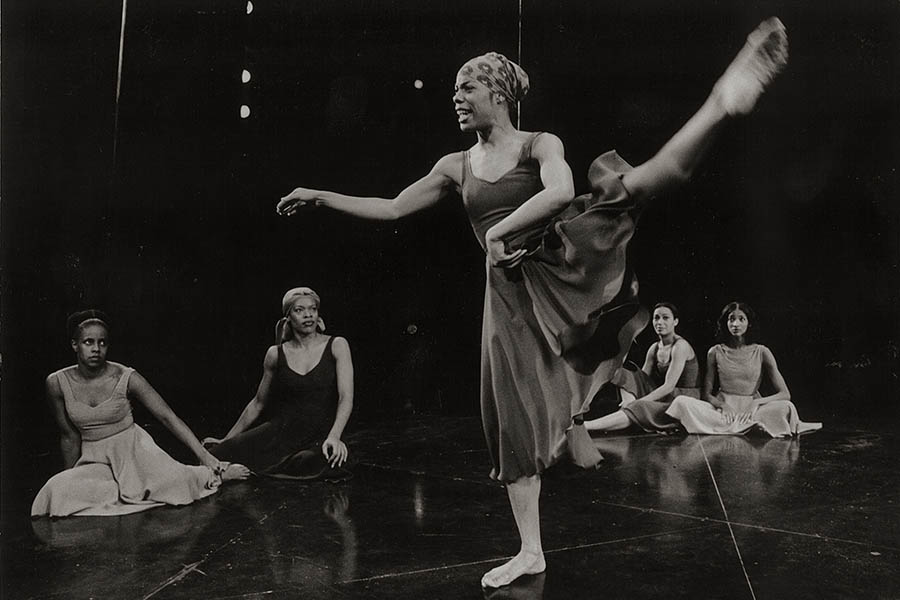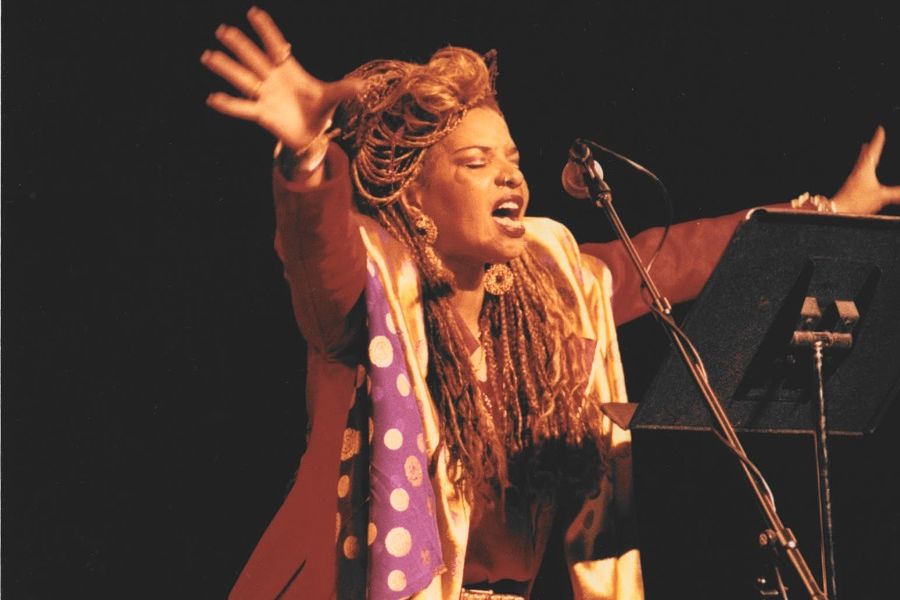Dance We Do: A Poet Explores Black Dance, the first posthumous release from Ntozake Shange’s timeless poetic voice, arrives when we need dance and theatre the most. As artists, when our art is at the center of our world, the people who explore that art with us can become the greatest loves of our lives. Shange admired the many artists she cites throughout Dance We Do as much as she inspired them in turn. This book, its histories wrapped in warmth, serves as a witness to a love exchange between artists who collectively changed the world through dance.
There are few strangers in Shange’s canon. Her work is radical because it disrupts colonial aesthetics and defies the proscenium, forcing audiences to inhabit their bodies. Her award-winning play for colored girls who have considered suicide/when the rainbow is enuf, her novel Sassafrass, Cypress & Indigo, and her poetry collection Ridin’ the Moon in Texas: Word Paintings, are a few examples of her keenly crafted aesthetic.
 This new work, released in October, is a pivot toward understanding Shange’s creative process more intimately. In Dance We Do, Shange is both a storyteller and a journalist collecting notes from the field and interviewing such artists as Mickey Davidson, Halifu Osumare, Camille A. Brown, and Dianne McIntyre. The book also contains prosaic writings about her encounters with legendary dancers Fred Benjamin, Eleo Pomare, Ed Mock, Dyane Harvey, and Raymond Sawyer. These creative engagements demystify what it means to become an artist. We see how alliances were formed. We see young artists experimenting with and developing their technique, while grappling with the implications of racism and gender as social constructs. And between productions, we see them embodying Black joy as a path to liberation.
This new work, released in October, is a pivot toward understanding Shange’s creative process more intimately. In Dance We Do, Shange is both a storyteller and a journalist collecting notes from the field and interviewing such artists as Mickey Davidson, Halifu Osumare, Camille A. Brown, and Dianne McIntyre. The book also contains prosaic writings about her encounters with legendary dancers Fred Benjamin, Eleo Pomare, Ed Mock, Dyane Harvey, and Raymond Sawyer. These creative engagements demystify what it means to become an artist. We see how alliances were formed. We see young artists experimenting with and developing their technique, while grappling with the implications of racism and gender as social constructs. And between productions, we see them embodying Black joy as a path to liberation.
Much like Shange’s larger body of work, Dance We Do replicates the practice of African griots, whose role has traditionally been to preserve their people’s genealogies, historical narratives, oral traditions, and praise songs. Preservation and prioritization of Blackness were at the core of her creative intuition, which can be seen clearly throughout the book.
“There is an entire creative component, filled with offerings in art, music, theatre, and dance,” said Reneé L. Charlow (she/her) in an interview. Charlow was Shange’s personal assistant from 2014 to 2018 and also wrote the Dance We Do afterword. With this book, said Charlow, Shange “bridges the gaps left by untold histories, and tells some of those missing and incomplete stories. She once told me her job was to say what she saw. With this book, we have just that.”
“The book holds stories of how Black people created spaces for dance against the odds in social climates that were not supportive or conducive, and gets into the nitty-gritty of how choreographers and founders of dance companies made it work.”
In Dance We Do, I found the tenderness my life has lacked in the last few months of the pandemic. These stories of colleagues becoming friends and friends becoming collaborators are love stories. In a hybrid essay/interview, Shange details “dancing to somebody’s music” one summer night at the East in Brooklyn. There she met dancer Bernadine Jennings, who suggested she audition uptown for a new company. After getting lost in Harlem, Shange landed at Dianne McIntyre’s Sounds in Motion studio, at which point she knew “that was where I was supposed to go.” The text then moves into an interview between McIntyre (she/her) and Shange, offering a glimpse into their multi-decade collaboration as comrades in dance.
“She never missed a class—a passionate dancer—such flowing and graceful limbs, an amazing full arch of the back,” McIntyre affectionately shared with me in a separate interview. “She was a dynamic dancer, indeed! I did not know for a long time that she was a writer—I knew her as a dancer from the depth of her soul.”
Dance We Do operates similarly to Indigenous storytelling circles with their emphasis on community connection. Shange met Mickey Davidson at McIntyre’s audition in Harlem. In her writing, Shange opens her memory to share their adventures of personal growth, motherhood, and public performance, as well as interactions with celebrated artists like jazz singer Jeanne Lee, experimental composer Sun Ra, and pianist Cecil Taylor. Shange and Davidson were both drawn to improvisation, which led to Shange saying how much she liked working with Davidson “because she pulled from the words more meaning than I knew they had. She let me let the words sit on a movement as though they were being sung by Marian Anderson or Harry Belafonte.”
In an interview, Charlow told me the book “fills a void that exists regarding literature on the work of Black dancers. There is limited published information about some of these luminaries, and even less of that information exists in one document.”
She’s right: There is a crisis in art criticism, and Black art is often misanalyzed and under-archived. Black dance criticism is at the crux of these realities. In recent years, journalists have exposed the white male critique’s dominance and the under-representation of Black-centered art by national news platforms. Dance We Do functions to push against this exclusion with specific decolonial interventions used too infrequently in art analysis. It also gives agency to primary sources. Shange’s appreciation for the artists she worked with means the artists do not have to defend their work or grapple with the white gaze. Instead, they are able to focus on aesthetics, skill, and experience in the field.

Shange addresses Blackness as a critical space of analysis without being reductive. Black artists’ connection to the diaspora is a lens through which they understand their bodies and storytelling. They are not “Black dancers” or “dancers who happen to be Black.” They are Black. They are dancers. The powerful intersection of these identities is unique for each narrative upheld in this new book. Crucially, Shange is not comparing the artists within the text; she honors each fully within the context of their work. Dance We Do brings nuance to its analysis. Shange is once again teaching us how to see and place value.
Dance We Do is a Black dance community portrait highlighting some of the most prolific dancers of our time—Shange’s colleagues, with whom she trained, danced, and auditioned. They are also cultural icons: Camille A. Brown, who choreographed Porgy & Bess at the Metropolitan Opera and received a 2019 Tony nomination for Choir Boy; Dianne McIntyre, a John S. Guggenheim Fellowship recipient; Dr. Halifu Osumare, whose dance contributions are global; Davalois Fearon, a member of the Joyce Theater’s Prestigious Young Leaders Circle Artists’ Committee; Otis Sallid, who produced a segment of Anna Deveare Smith’s HBO film Notes From the Field; and Dyane Harvey, whose screen credits include Free to Dance, The Wiz, and Ailey Celebrates Ellington.
This book proclaims that we should give Black art, Black dance, and Black artists their flowers. Their groundbreaking work deserves in-depth scholarly analysis, culturally competent journalistic review, and respect. Once again, in true Shange fashion, she is holding the door open to teach us how to engage with Black artistry. She is directing our gaze to the most pressing dance histories of our time. Alexis Pauline Gumbs (she/her), the literary advisor to the Ntozake Shange Revocable Trust, who also penned the Dance We Do foreword, said to me in an interview that she hopes this collection also inspires theatremakers to continue to create.
“No matter what—find a way to remain in forward motion and continue to create,” said Gumbs, who is also the author of M Archive: After the End of the World and Spill: Scenes of Black Feminist Fugitivity. “The book holds stories of how Black people created spaces for dance against the odds in social climates that were not supportive or conducive, and gets into the nitty-gritty of how choreographers and founders of dance companies made it work.”
In a time when many theatre artists feel paralyzed by COVID-19 industry closures, it is essential, as Gumbs explains, to remember that Shange’s work “has always pushed the limits and dared to defy the norm; her creative practice was, in fact, the spiritual work of honoring all of these selves.”
Dance We Do reminds readers that community connections and perseverance are necessary to succeed in creative careers. It proves that friendships are required to succeed in life, it reveals the process of creation as collaborative, and it is an evocative reminder to be gentle with ourselves as humans who create and dance through life. Or, as Shange puts it in the introduction, “To realize one has a body and to feel that body in motion, flying, stomping, sweating, sliding, turning, cascading in somersaults, or crossing the floor in a grad chassé or a grand battement, is to know freedom.”
Jamara Wakefield (she/her) is an award-winning writer, poet, and community organizer who writes for publication and stage. She currently has bylines for Shondaland, Playboy, Wear Your Voice, Our Prism/ Daily Kos, B-Word, RaceBaitr, CUNY, Black Youth Project, the Root’s Very Smart Brothers, Zora, and DAME.


